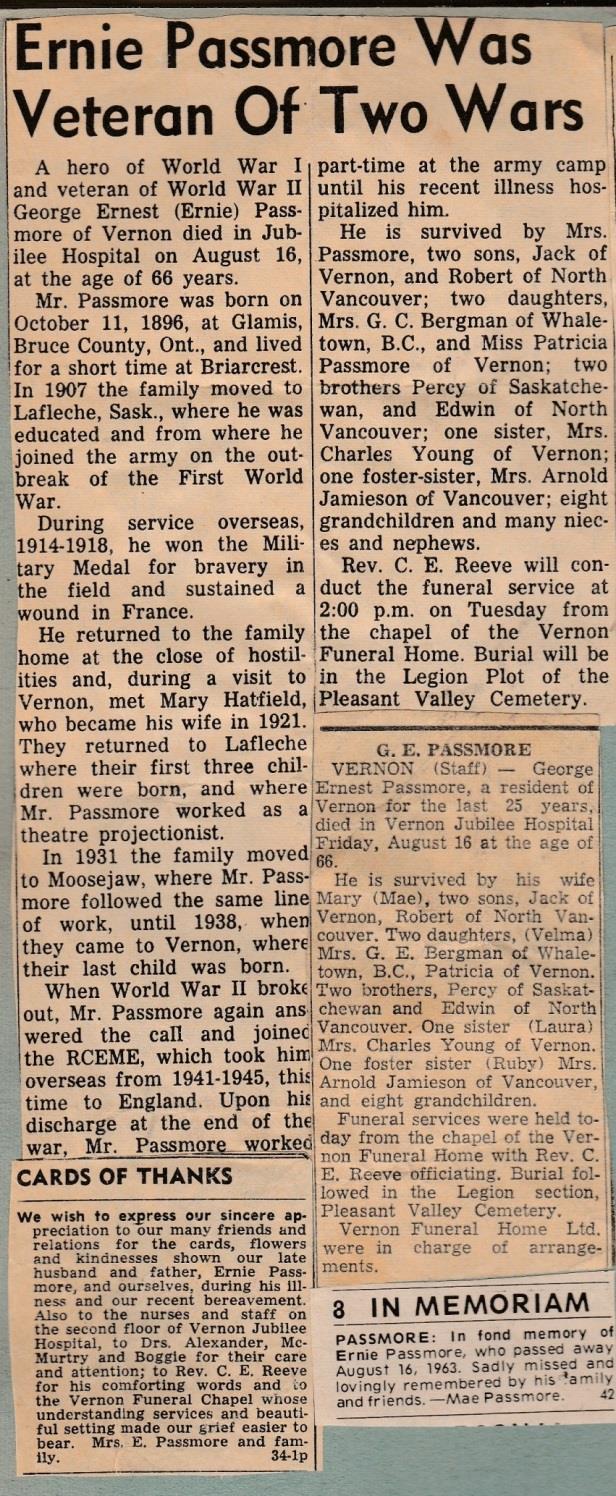Ernie Passmore World War # 1 and World War # 2 by Bob Passmore
These notes were compiled by me over the last 64 years from interviews, military records and various books relating to World War # 1. Other than discussions with my Dad, the most significant of these sources were an interview in Victoria with his platoon Commander George B. B, Shaw in 1949, the 2nd Volume of Shock Troops by Tim Cook, Dad’s War record obtained from Archives Canada and the World War # 1 Diary of the Fifth Battalion Western Cavalry
George Ernest Passmore (Ernie) was born at Glammis, Bruce Twp., Bruce County, Ontario, on October 12, 1896. The record can be found on page 89 of the Register of Baptisms kept at the Church of England Rectory, Bervie, Ontario, The Baptism was recorded as #168 on February 16, 1897, residence: Glammis, Officiating Clergyman E. A. Hall.
Ernie Passmore, as he was known, lived on a farm with his parents and siblings, on Con. 9, lot 15, near Glammis, Ontario. There is some confusion regarding the location of the farm because some family records show that they lived at the “Eighth of Bruce" not the 9th Con.
At the age of 10, Ernie and his entire family moved to Briercrest, Saskatchewan in 1908. His family moved to Drinkwater in 1908 and then to Lafleche in 1910. He was educated in Lafleche but not much is known about him until he joined the army at Weyburn, Saskatchewan on March 14, 1916.
He told me that in 1915 he rode his horse “Diablo" from Lafleche to North Battleford, Saskatchewan and back to visit a relative. During this long ride across country he never ran into a fence.
Ernest Passmore enlisted at Weyburn Saskatchewan on March 14, 1916. His birth date is shown as October 11, 1895, not October 12, 1896 as recorded in church records. We were told that he lied his age but why would he when he was old enough anyhow. His Army Attestation Paper shows that he was an engineer and his next of kin was his mother Mrs. Edward Passmore. He called himself an engineer because he operated the steam tractor that provided the power take off for the threshing machine.

He was posted to the 152nd Bn. C.E.F. at Camp Hughes in Ontario, Canada. His Regimental No. was 925525.
Image - Alfred Hayes, Edward Passmore, Ernie Passmore and Catherine Passmore at Lafleche 1916. Grandma Catherine Hayes wrote on the back of the picture “My soldier boys”.


On October 3, 1916 he embarked for England with the 152nd Weyburn Battalion on the SS Miisanabie and arrived at Liverpool on October13. He was transferred to the 32nd Bn. at East Sandling on October 21, 1916 and was admitted to Moore Barracks at Sutcliffe on December 25, 1916 where he was diagnosed with mumps. He was discharged from the hospital on January 6, 1917. That must have been some way to celebrate his first Christmas and New Years away from home! He then proceeded to the 15th Reserve Btn., back at East Sandling on January 6, 1917. On March 5, 1917 he was transferred to France where he was taken on strength with the 5th Battalion Western Cavalry on March 16, 1917. This was just in time to take part in the Canadian Corps epic attack on Vimy Ridge April 9, 1917.
He was placed into "A" Company, fifth Battalion, 2nd Brigade of the 1st Division which was in the first wave on the extreme far right of entire Canadian attack.
Prior to this time the Canadians fought under British command. This was their first battle as a complete Corps with their own officers. The Canadians decided to make radical changes to the system of attack. Prior to Vimy, the British and French went over-the-top and attacked while walking forward into the face of machine gun and artillery fire that had been set on fixed lines by the enemy. The enemy machine guns were fixed to fire at a height of about 4½ feet, thus hitting the attackers in the chest. At Vimy the Canadian artillery had identified each German gun and had ranged in on these. When the Canadians attacked, the infantry used what we now call battle drill.
Each platoon of about 40 men was divided into three sections. Following a creeping artillery barrage the first section would run forward at the crouch below the worst of the machine gun fire for about 30 paces and drop down. The second and the 3rd sections would alternately follow them, while the sections on the ground would provide covering fire. The sections would continue to advance in leap-frog fashion. Before the German gunners could range into one advancing section they had dropped to the ground and another group were attacking. When they got to within 30 yards of the German trench, they would all rise and charge with fixed bayonets and hand grenades. Each man was well briefed on his objective and knew where to go and how to get there. A Vickers machine gun was assigned to each attacking Company that would be brought forward when the first objective was captured.
Image - Vickers heavy machine gun
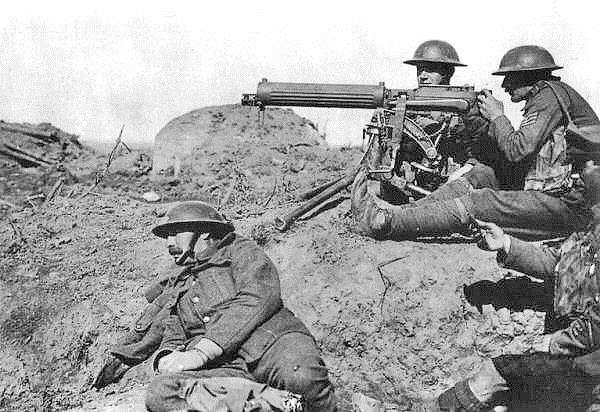
Each of the four platoons in a Company was equipped with a portable Lewis machine gun that could be fired from the hip.
Image - Lewis light machine gun fired standard .303 ammunition. About six men from each platoon were detailed to carry extra loaded drums.
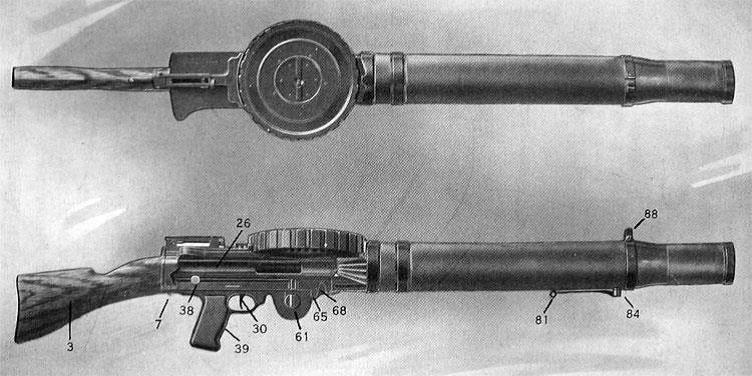
One man from each section was equipped with a special rifle that could fire a grenade about 50 yards.
Image - Rifle Grenade
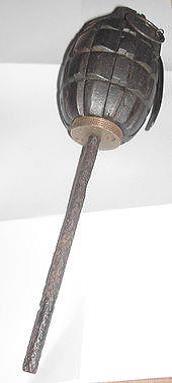
With four companies in a battalion, the combined fire power, when they reached their objective, would be four Vickers heavy machine guns, sixteen light Lewis machine guns, forty-eight rifle grenades plus a few two inch trench mortars. The additional firepower enabled the Canadian attackers to withstand counter attacks and to engage enemy strong points and machine gun positions.
Vimy Ridge was the first real successful allied attack in nearly three years of fighting. It is said that both sides had lost ¼ million men in previous attempts to take the ridge by the British and French Armies.
Image - The fifth Battalion’s objective is circled at the bottom of the map.
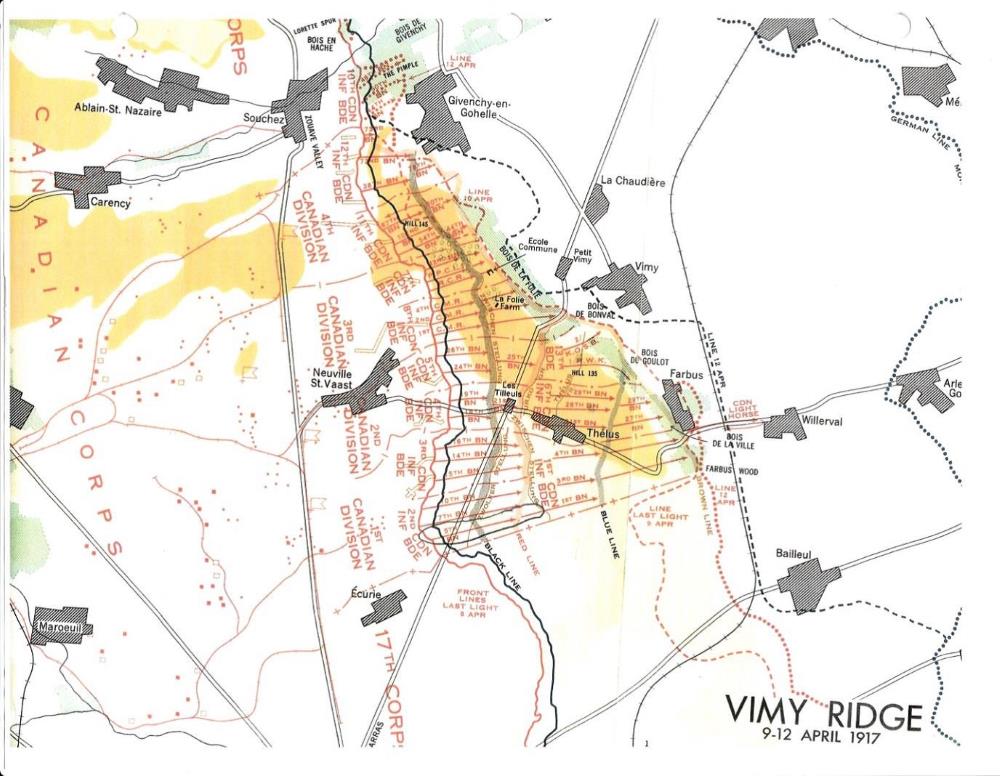
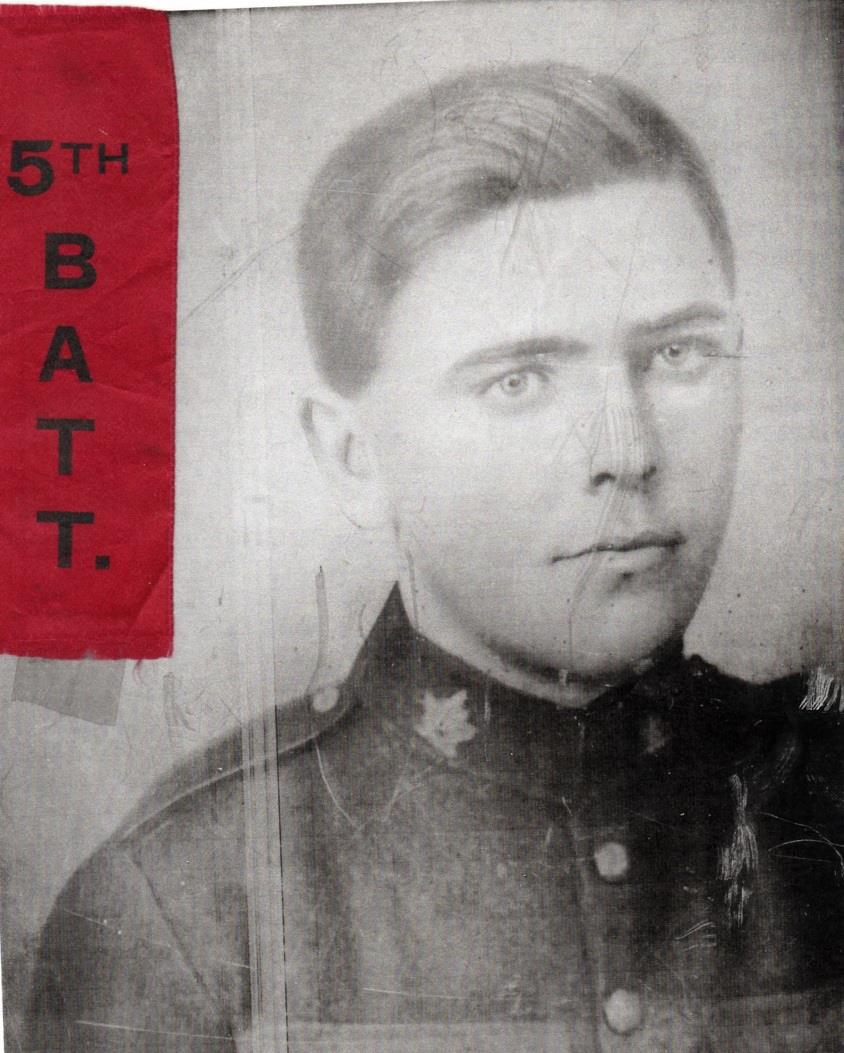
The following was taken from the War Diary of the Fifth Battalion:
About 10:00 PM on April 8 the Battalion moved forward into no-man's land. A and B Companies being situated about 75 yards from the enemy's front line. At zero hour 5:30 AM the artillery bombardment thickened into an intense barrage. At zero plus 3 the barrage lifted and A and B Companies went rapidly forward occupying the enemy's front line with little opposition from the surprised Germans. Immediately after advancing from that front line position they encountered severe hostile machine gun fire from a sunken road which killed several officers and a large number of other ranks.
After a very stiff fight using their bayonets to good affect they cleared the enemy from the location and took several prisoners. Several machine guns held up the advance to the trenches comprising the black line, that was our initial objective, but these were effectively silenced by our rifle grenades. The plan was to have C and D Companies pass through them once the black line was reached but heavy machine gun fire was raking the trench and could have compelled A and B Companies to withdraw or be cut to pieces. With great initiative they decided to deviate from the operational orders and sweep beyond the initial black objective putting the troublesome machine guns out of action.
This action drew the fire from enemy guns at the final objective and enabled C and D Companies to swiftly move forward towards their objective. At this time a bombing party from A Company was ordered to silence several machine guns to their right that were causing heavy casualties. After a stiff fight utilizing rifle grenades followed by a bayonet attack, the machine guns and dug outs were put out of action and the attack towards our objective was resumed. The Battalion successfully reached the red line on high ground and put many of the enemy out of action. Our troops dug in and consolidated the position. The enemy position disclosed ample provisions and almost luxurious conditions of life. Electric lights were still burning, elaborate telephone systems were still in operation, hot coffee and other refreshments provided a well-earned respite for our troops. This was the German main defensive position and it was taken by the Canadians by 9:00 AM. Of the 803 men of the 5th Btn. who went over the top at 5:30 AM, 364 were listed as casualties.
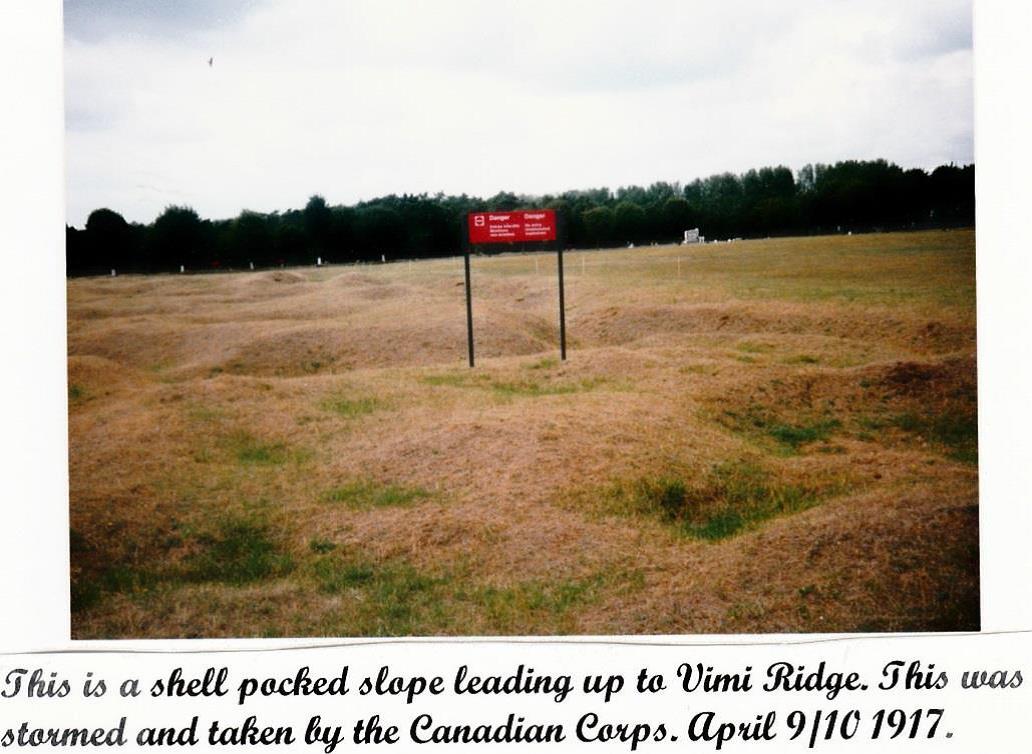
The following description of that assault was taken from the book "Shock Troops" by Tim Cook:
The 5th Btn surged forward behind the creeping artillery barrage overwhelming the first line of their objective sustaining few losses. The fury of the infantry attack carried them through barbed wire and thousands of shell craters. The second line fell quickly but the third line, their final objective, 1100 meters beyond, was alerted to the attack and recovered from the initial shock. In addition, German machine gun fire from the right mowed down dozens of Canadians. Many of the German guns were outside the battalion's boundaries in an area that was to be taken by the British 16th Corps to the Canadians right.
Risking friendly fire and being slaughtered by the British, dad’s "A" Company of the 5th was ordered to assault those machine guns. They charged the German positions with bombs, bayonets, Lewis guns and rifle fire. The Germans put up heavy resistance but were overwhelmed by the fury of the Canadian attack. After the guns were silenced, "A" Company returned to their own sector. The assault on the third line was then continued. The Germans on the 5th's final objective had been in deep dugouts and manned their guns when the barrage lifted. The Germans fought to the last man but were overcome in bitter hand-to-hand fighting. The 5th Btn. then let the 1st and 3rd Battalions in the next wave pass through to assault the higher ground which was the final objective of the 2nd Brigade. On top of the ridge, the victorious Canadians looked down on the Douai Plains on the other side of the ridge.
Image - This is the part of Vimy Ridge that the Fifth Battalion attacked
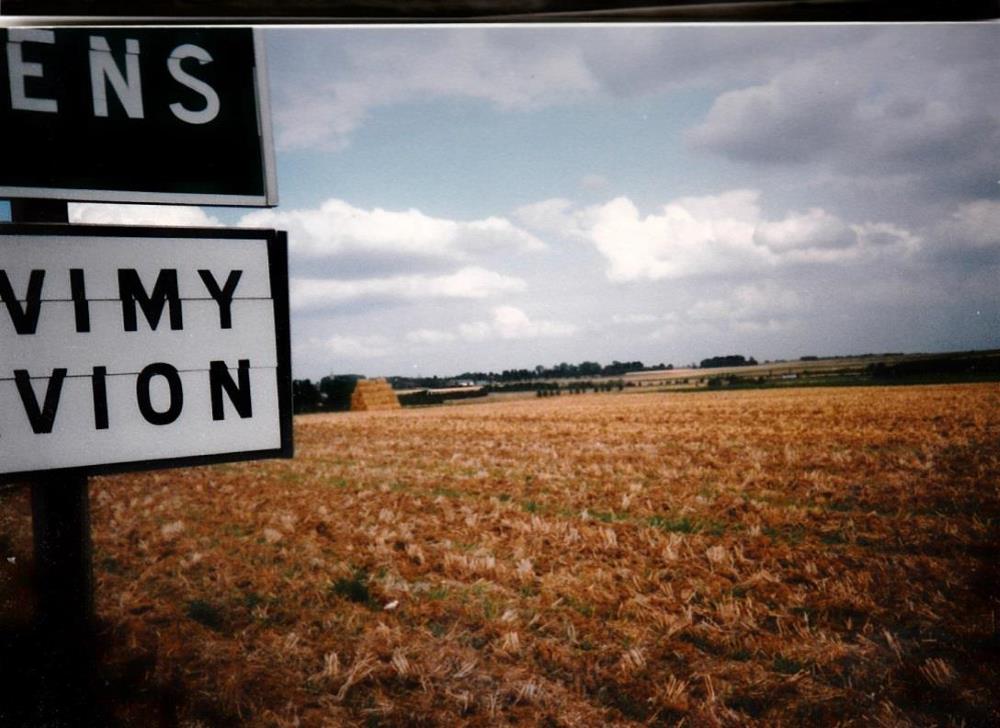
During the third day of the attack some elements of the 5th took part in the successful assault on the "Pimple, the highest point on Vimy Ridge. The victory was not won without a great loss. The Canadian Corps suffered 11000 casualties in the attack, 3600 of these were fatal.
The official history of the Canadian Expeditionary Force only mentions that the 5th took their final objective at 9:00 AM. It fails to mention that the 5th Btn. was faced with heavy German machine gun and artillery fire and that their objectives were only taken after fierce hand to hand fighting and many acts of individual bravery. Nor does it mention that they incurred over 45% casualties in 3½ hours of fighting.
The next Canadian offensive was the assault on Hill 70 near Lens August 15-25, 1917. The 5th formed the left flank of the attack on the town of Arleux-en-Gohelle a critical position needed to protect the Canadian assault on Hill 70.
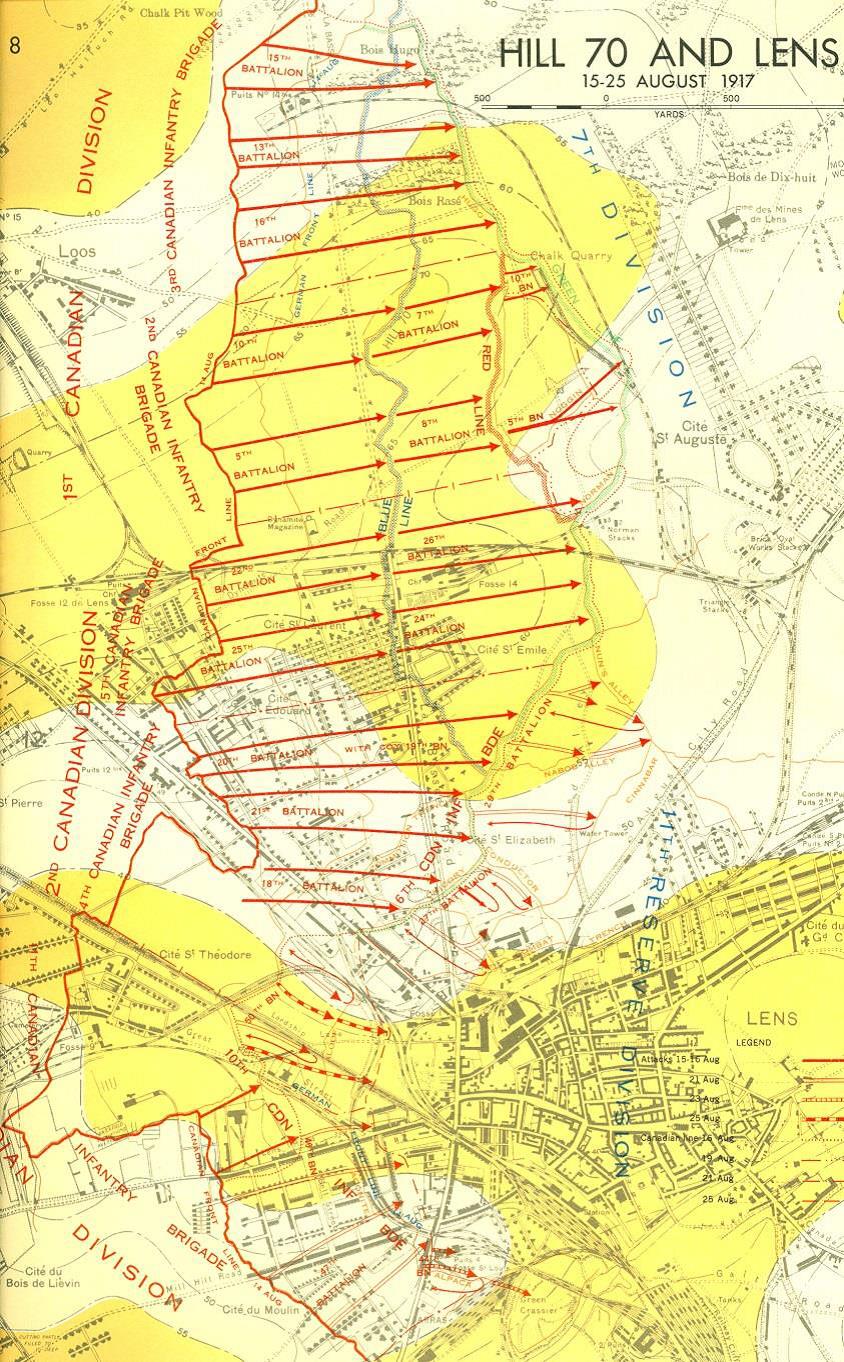
The 5th Btn was in the first wave of the Attack on August 14, 1917. "B" & "C" Companies took the German front line incurring very few casualties. When dad’s "A" Company passed through the other Companies on the way to the blue line, they were heavily shelled and machine gunned before reaching their objective. "A" Company captured over 30 Germans and 2 machine guns and trench mortars. The two Companies lost 125 men in this assault mostly from "A" Company (dads). The 8th Btn. (Little Black Devils) then passed through the 5th to take the red and green lines. On the evening of August 15th "A" & "B" Companies relieved the 8th in the front line. German aircraft spotted for their artillery and brought in heavy shelling on the Canadian trenches. In a desperate effort to stop the Canadians, the Germans then used mustard gas for the first time against the Canadians. Respirators provided reasonable protection against Chlorine gas but were not effective against mustard gas that was absorbed through the skin. The gas caused severe casualties to the Canadians who were exposed to it.
Several counter-attacks were beaten off during the evening of August 15. On August 16 "A" & "B" Companies, after receiving the Battalions reserves were ordered to assault the railroad line on the far side of the hill. After heavy fighting the objective was taken but continuous enemy counter- attacks, mustard gas and heavy shelling forced them to withdraw 175 yards east of the railroad. "A" & "B" Companies now were reduced to only a few able bodied men. At 6:30 PM reinforcements arrived and they pushed forward within 100 yards of the railway but that is as far as the got. On the night of the 17th they were relieved by the 4th Battalion. Casualties in the 5th Btn. totaled 13 officers and 352 other ranks.
The attack was considered to be a success even though they failed to take the City of Lens to the south of where the 5th was operating. The Germans brought in two Divisions of their best troops from Flanders in order to stop the Canadians. These included their crack German Guards Regiment. German losses were over 15,000 against about 5500 for the Canadians. The British at Flanders were happy to see the Germans pull 2 Divisions from the Flanders front.
After 12 days in the 1st army rest camp dad rejoined his unit on October 16, 1917 at Passchendaele [The Third battle of Ypres] October 20 to November 10 (page 176-177). Whereas Vimy and Hill 70 were bloody battles, they were fought on relatively dry ground. Passchendaele was a quagmire in the sunken fields of Flanders with shell holes full of water and water everywhere.
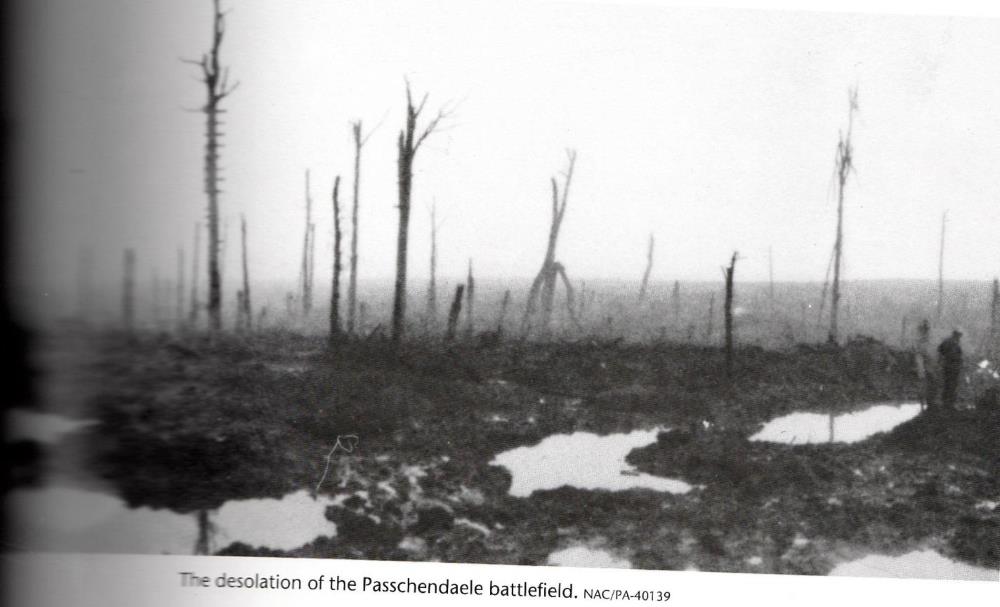
Wounded men drowned in the ooze and the duck boards that were laid out as paths even disappeared in the bloody slime. Moving forward in the mud was nearly impossible even if there had not been for German pillboxes and machine gun nests firing down at them at point blank range. On top of this the Germans had ranged in the killing fields of Flanders with devastating artillery, mortar fire and the deadly mustard gas. The 5th Btn. fought the enemy in close combat over a 17 day period. Towards the end of the battle the 2nd brigade, including the 5th Btn. was successful in taking Passchendaele Ridge on November 10, 1917. Dad was wounded on that date and was admitted to No.11 CC Station field hospital on November 10, 1917 suffering from concussion and contusions. The total Canadian casualties in the assault was over 16,000.of which 320 were from the 5th Btn., including dad.
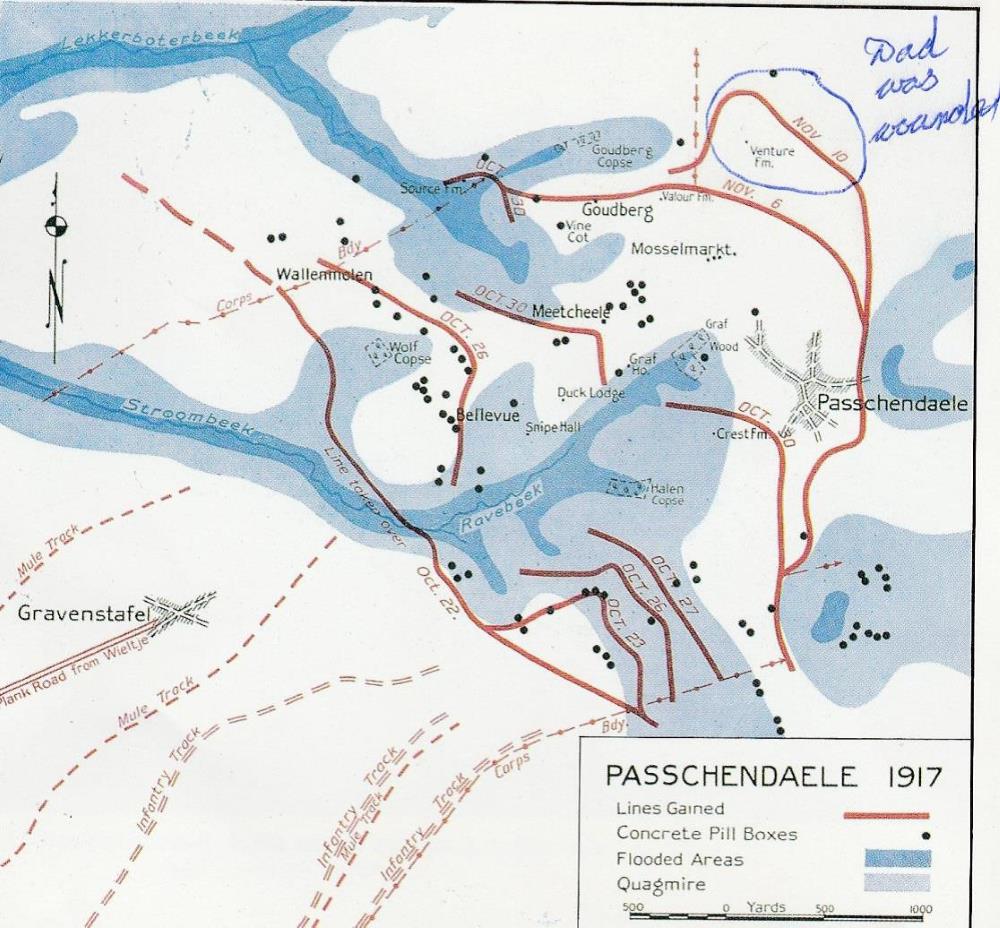
Although he was released from hospital on November 19 and rejoined the 5th Bn. on November 24, a series of infections and other illnesses caused him to be hospitalized for several months. This prevented him from taking part in any action until later in the summer of 1918.
On January 6, 1918 Ernie Passmore was granted 14 days leave in the UK and returned to his unit on January 21, 1918. He was diagnosed with scabies on February 28 and was admitted to the 4th Cdn. Field hospital where he stayed until March 24. He was returned to duty March 29 and rejoined the 5th Bn. on April 2, 1918. The Battalion was in reserve at that time. He was then diagnosed with cellulitis of the abdomen wall on April 15 and admitted to #7 CCS hospital at Rouen, France until May 8, 1918.
After the above terrible battles, things were relatively quiet for the 5th until August 8, 1918 which was the opening battle of the "Last 100 Days". Dad’s record shows that when he recovered, he was initially posted to the 8th Battalion (Little Black Devils) on August 18. At this time, the 8th were in reserve after suffering heavy casualties at the "DQ Line" earlier in the month. On August 30, according to the Regimental Diary, the 8th were ordered back into action east of Arras. Their objective was to take a series of German trenches south of the Arras to Cambrai Road called Olive and Ostrich trenches. They succeeded and established a line astride of the road suffering 98 casualties. The 8th was put into reserve until September 7 when Ernie was again returned to the 5th.
By coincidence, when I visited this Battlefield in 1990, I stopped near a Canadian Cemetery on the north side of the Arras Road and found a plaque near the Cemetery. It honors the Canadian Victory in breaking through the Hindenburg Line.

Dad was with the 8th Battalion "Little Black Devils' on the dates mentioned on the above plaque.
In the meantime the 5th had been involved in heavy fighting and was then in reserve. The series of battles during the “last 100 days” started with the Battle of Amiens then the breaking of the Hindenburg Line near Arras and then breaching and crossing the Canal Du Nord and on to Cambrai.
The following map illustrates the final push to break the Hindenburg Line at the Canal Du Nord. I have marked Epinoy that is just beyond the Village of Haynecourt where dad won the Military Medal for Bravery in the Field.
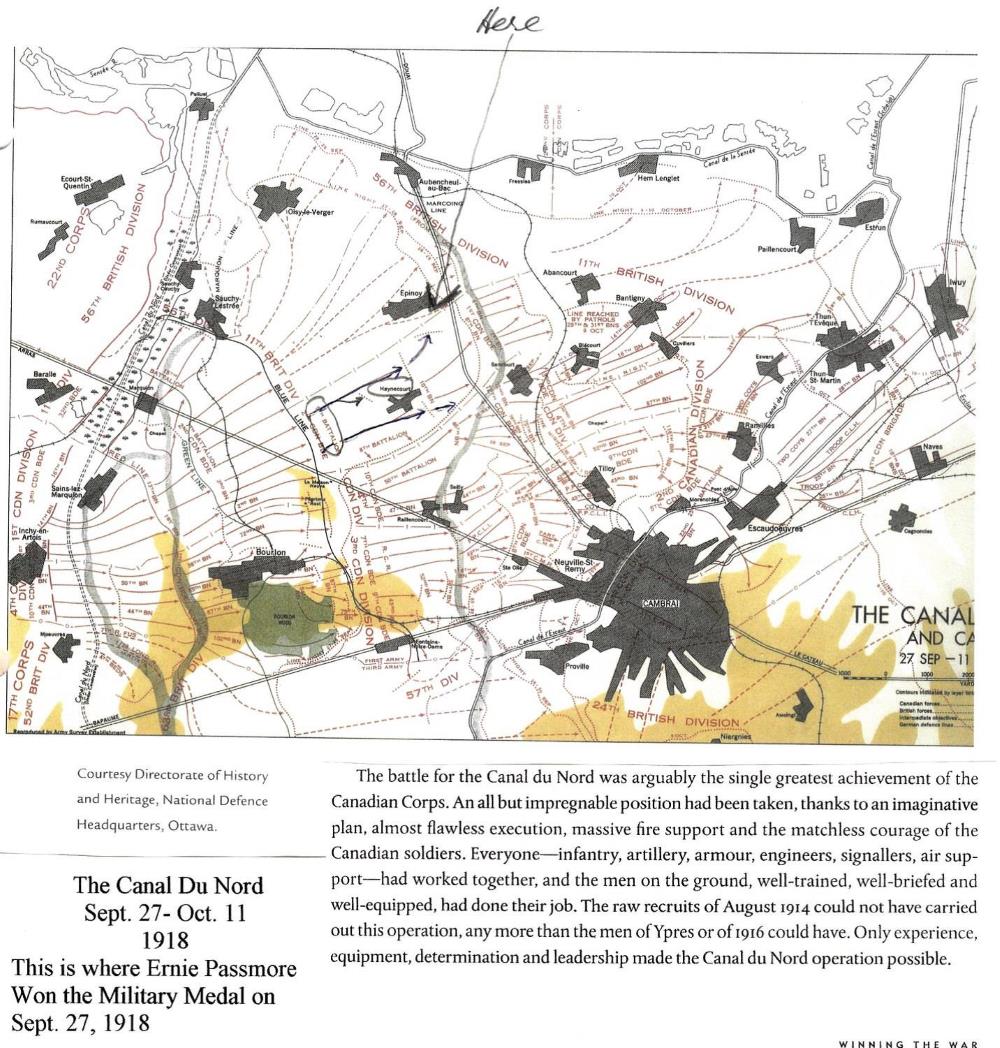
World War # 1 Maps show the Hindenburg Line in this area as being just east of Arras. In fact it occupied the entire area between Arras and Cambrai a distance of 48 Kilometers. The first series of fortifications started just east of Arras and were about 6000 Yards deep. This was followed by about 10 miles of lightly defended connecting trenches before reaching the Canal Du Nord where another 7000 yards of heavily fortified trenches and concrete pillboxes had been established that extended to the outskirts of Cambrai.
The 5th Btn. went into action at 3:00 PM on September 27 after other units of the 1st Brigade had fought their way across the Canal Du Nord and then were leap-frogged by units of the 2nd Brigade. The remaining three Battalions of the 2nd Brigade, the 5th, 8th and 10th Battalions then passed through and fought their way through to the enemy positions. The 5th was in the vanguard of the 2nd Brigade and broke through the German defences capturing Haynecourt and a series of trenches to the north of the village, before digging in facing Epinoy. Their advance had put them ahead of the other units on either side. The British 11th Division on on their left that had failed to reach their objective. They lost contact with the 8th Btn. that was to relieve them. It was here at the Village of Haynecourt, just across the Canal Du Nord, that Ernie won the Military Medal for Bravery in the Field. . The following was told to me when I met his former platoon commander in December 1949. He was then known as Captain John B. B. Shaw).
The Company Commander asked for volunteers to get word back to the main lines that they had reached their objective but needed artillery support as well as ammunition and supplies. Off to their right, behind a ridge, they spotted a German artillery position that could not be seen by the Canadian artillery at the jumping off point of the attack. The volunteers would be given the co-ordinates of the German guns and of several pill boxes and asked to run back to the Brigade headquarters through the German lines. The Germans had infiltrated back into the trenches that the 5th Bn. had captured earlier. Two men stepped forward but were cut down by those guns and machine guns within meters of leaving the Canadian held trench. Two more men stepped up and in a lull made a break for it. Both were cut to ribbons as they sprinted toward the rear. The Company Commander asked for two more volunteers and two more stepped up knowing the odds. One of these was Ernie Passmore. The wait for another lull was agony for these men and for Captain Shaw who watched them leave with lumps in his throat. One runner was killed but Ernie made it through the crossfire, even as bullets tore through his uniform. Several Germans came out of their trench to capture him. After hand- to-hand fighting with rifle, hand grenades and bayonet in which he killed several of the enemy he was successful in reaching Brigade Headquarters. Shaw told me that the thing that saved Ernie's life was because the Germans desired to take a prisoner and get information about the strength and condition of the Canadians that had penetrated the German lines. That is why the Germans called off their shelling and machine gunning and sent a patrol out to capture the surviving Canadian runner. They didn't think that he would wipe out their patrol. Shaw said that one of the Germans that Ernie had wounded got up with intentions to bayonet Ernie in his back. Shaw shot that German. Within minutes of Ernie reaching the 2nd Brigades lines, 18 pounder shells from Canadian guns came crashing down and annihilated the German positions that had been shelling and machine gunning the 5th Battalion lines. Units of the 2nd Brigade, including the 8th and 10th Btns., then moved forward through the gap, guided by Ernie, and relieved the beleaguered 5th Bn. The 8th and 10th reached their objectives and dug in awaiting enemy counter attacks.
Image - Record of the award of the Military Medal
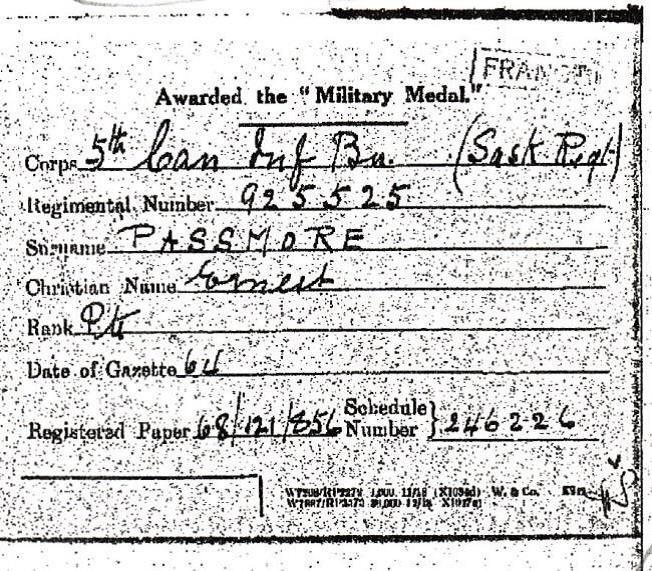
The Hindenburg Line had now been breached and the Canadians took the City of Cambrai a few days later. Cambrai had been occupied by the Germans for most of the War. Regarding his award of the Military Medal, no “Deed of Action" was published at the time it was recorded in the London Gazette No. 31430 dated July 3, 1919.
The 5th lost 260 as casualties in this battle.
I have obtained a copy of a Documentary called "For King and Country, the Last 100 Days" in which we have identified dad marching by the camera near the Belgian Border. This likely took place on October 11, 1918 near Bellonne on their way to Masney. How many individuals have a film of their dad marching into a decisive battle?
Ernie subsequently incurred minor wounds when he took part in the final breakthrough of the German lines on October 15 when they attempted to cross the Sensee Canal near Goeulzin and was sent to the 1st Army Rest Camp from October 15 until November 2, when he rejoined the 5th Bn. at Masny where the Battalion was stationed until after the Armistice.
It is interesting to note from the Diary that word came on November 9 that German Officers were negotiating an armistice. The 5th were taken out of the front lines but no further word about the armistice was received until the evening of the 11th about 10 hours after the Armistice was established at 11AM November 11, 1918. The 5th later began their long march through Belgium to the German Border. On December 6, 1918 the Battalion crossed the German frontier at Oppenbach and was reviewed by the Corps Commander. The band played “When We Wind up the Watch on the Rhine” and “Hail Hail the Gangs all Here” as they crossed the German border. On December 13, 1918 the 5th Btn. marched in a steady rain to Cologne Germany a distance of about 32 KM to take part in a General Review marking the crossing of the Rhine River. Before reaching Cologne they were halted to clean up and place their rubber rain capes into their back packs. They donned their steel helmets, fixed bayonets and crossed the Rhine on the Cologne River Bridge at 1110 hours where they were reviewed by French, British and Canadian Generals. This crossing of the Rhine was captured by news reel cameramen and has been featured on several WW#1 Documentaries. I could not identify dad in this film.
Image - Officers of the Fifth Battalion Western Cavalry near the Belgian Border November 1918
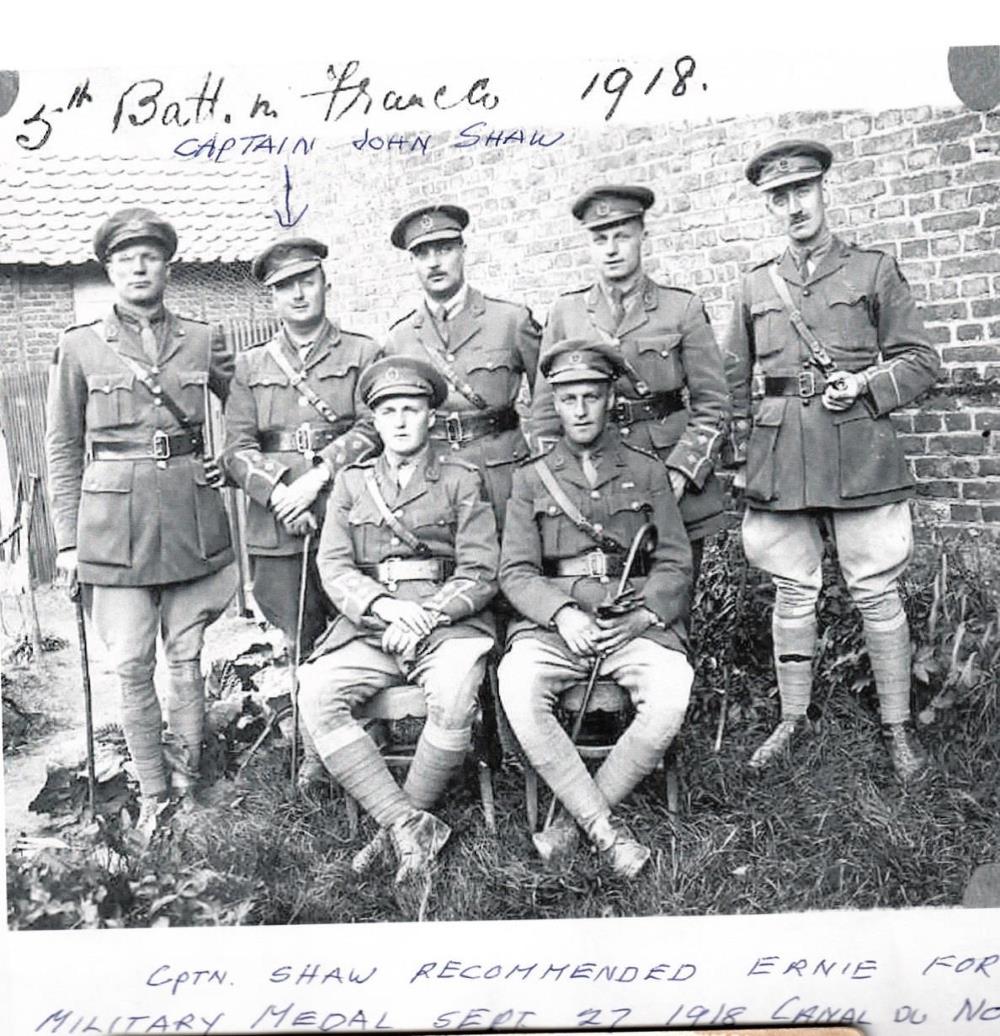
On February 4, 1919 about 100 members from the Battalion were transported to Liege, Belgium to take part in a General Review of the Canadian Corps by the Commander of the Belgian Army, General Jocques and Lt. General Sir A. W. Currie, Commander of the Canadian Corps. The 5th Battalion (Western Cavalry) led by their mascot "Sergeant Bill", were given the honour of leading the whole of the infantry of the 1st Division. Dad was one of the 100 men from the 5th Btn. that were transported by rail to take part in the parade at Leige. He was very proud of this honor
Image - A Company fifth Battalion in Army of Occupation in Germany January 1919. Dad is 3rd row from top center of picture.
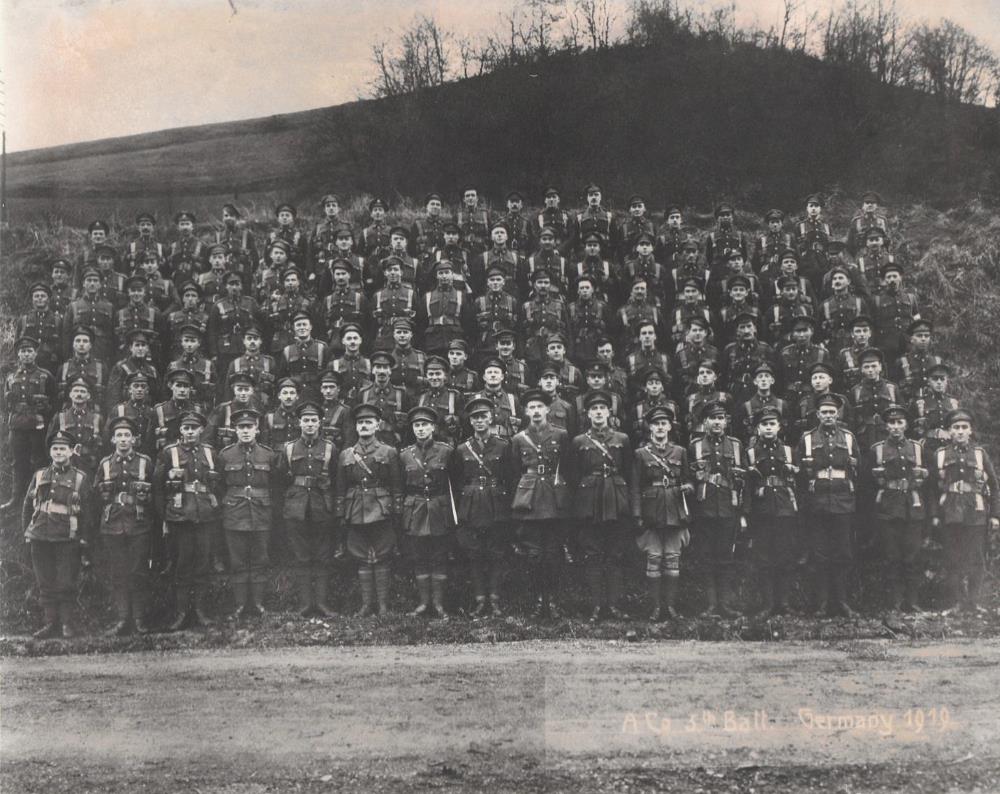
Ernie served in the Army of Occupation in Germany until January 15, 1919, when he took two weeks leave in the UK and then returned to his unit in Germany.
The 5th Bn. was sent to England on March 19, 1919 and embarked to Canada on the SS Carmaia on April 10, 1919. The ship was disembarked at Halifax on April 18. He was discharged on April 24 and was sent to Wayburn, Saskatchewan on April 29, 1919 for dispersal. He received back pay and travel allowance of $544.81 and War Service Gratuity of $420.00 upon his discharge. His pay was about $34.10 per month.
The mascot of the 5th Btn was a billy goat named Sergeant Bill. Enroute to Camp Valcartier, Quebec in August of 1914 the 5th Btn's train stopped at the town of Broadview, Saskatchewan. Some children that were cheering the troops along the track had a pet goat and when one of the soldiers jokingly asked the little girl who was holding the goat if the battalion could have it as a mascot the little girl answered, "Take him along, he will bring you luck". Bill went with the battalion to France February 13, 1915 into the trenches at the 2nd Battle of Ypres on April 22nd of 1915. He was gassed, wounded and decorated with medals including; The 1914 Star, The General Service Medal and the Victory Medal. Bill was recognized as the Senior Mascot of the Canadian Expeditionary Force in WW # 1. After the War he was safely returned to Canada, finishing his years out to pasture near his hometown of Broadview. Upon his death he was stuffed, mounted and placed for a while in the Saskatchewan Legislative Building in Regina. He was subsequently returned to Broadview where he remains honoured in the Broadview Museum.
Image - Sergeant Bill in uniform at the front
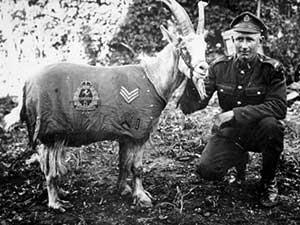
Major Battles and Honours of the 5th Btn. Western Cavalry, 2nd Brigade, 1st Division: 1915 : Ypres 1915; St Julien, Festubert, Mt. Sorrel and the Somme 1916 : Thiepval, Ancre Heights and Arras 1917 : Vimy Ridge, Arleux, Hill 70, Passchendaele, Amiens and Scarpe 1918 : Drocourt-Queant, Hindenburg Line, Canal du Nord, Pursuit to Mons. This is a quote from the Commander of the Canadian Corps: “In no battle did the Corps fail to take its objective nor did we lose an inch of ground, once that ground was consolidated and in the 51 months that it had been in the field the Canadian Corps has never lost a single gun. I think one cannot be accused of immodesty in claiming that the record is somewhat unique in the history of the world’s campaigns”.
When WW # 2 started, Ernie tried to enlist in 1939 but was rejected due to bad teeth. He got his teeth fixed up and tried again. He was accepted and enlisted on June 22, 1940, Regimental # K-37858.
Image - Dad, Mom and me in Vernon 1940
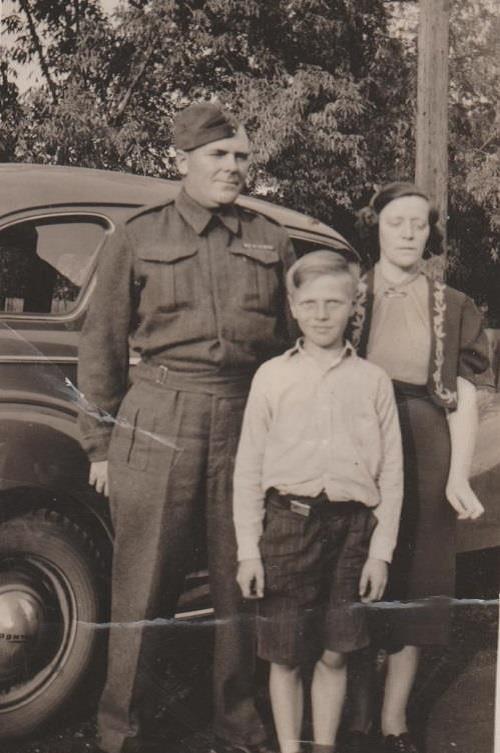
He enlisted with the Duke of Connaught's Own Rifles [British Columbia Regiment) and is in the famous picture of the Regiment marching down Eighth St. New Westminster, supposedly to embark on a ship going Overseas. They were actually leaving for Nanaimo for advanced training. The picture was featured in Life Magazine at the time and again in 1950 as one of the best pictures to appear in Life during the first half of the century. It also is on the cover of Peter Neuman's Book “The War Years" and in the book “Our Canada”. The picture frequently appears on television around Remembrance Day and has been featured in the Vancouver Sun several times. In October 2014 a statue portraying the famous picture was unveiled at the location in New Westminster where it was taken. The unveiling ceremony appeared in several newscasts at the time and the story behind the picture was explained.
To commemorate the unveiling of the statue the Canadian Mint coined a two dollar coin showing a part of the famous picture. I gave each of my children and grandchildren one of these coins.
Image - The two dollar coin minted to commemorate the anniversary of the Wait for me Daddy picture. The man in the foreground is the boy in the picture.
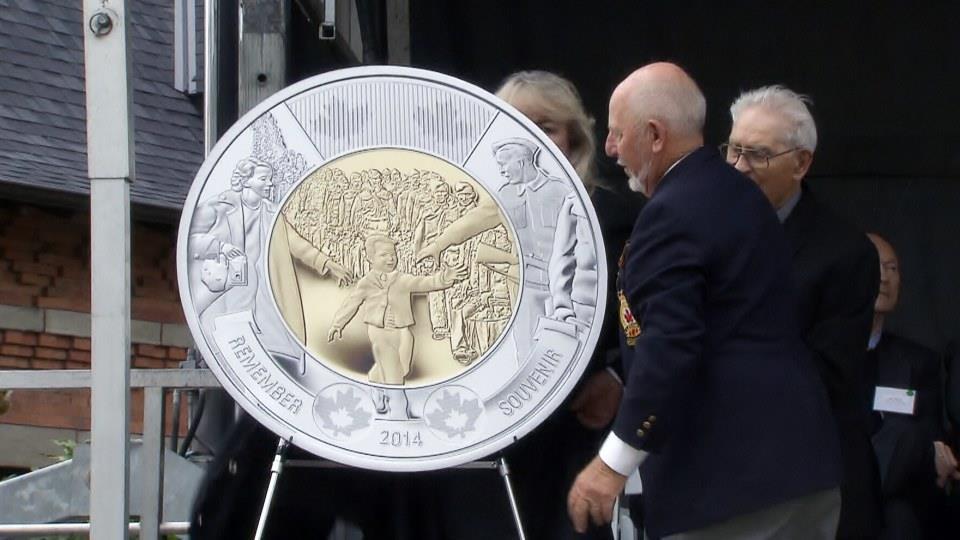
Image - Wait for me Daddy picture October 1940 in New Westminster. Ernie Passmore is the shorter soldier center row above boy’s head
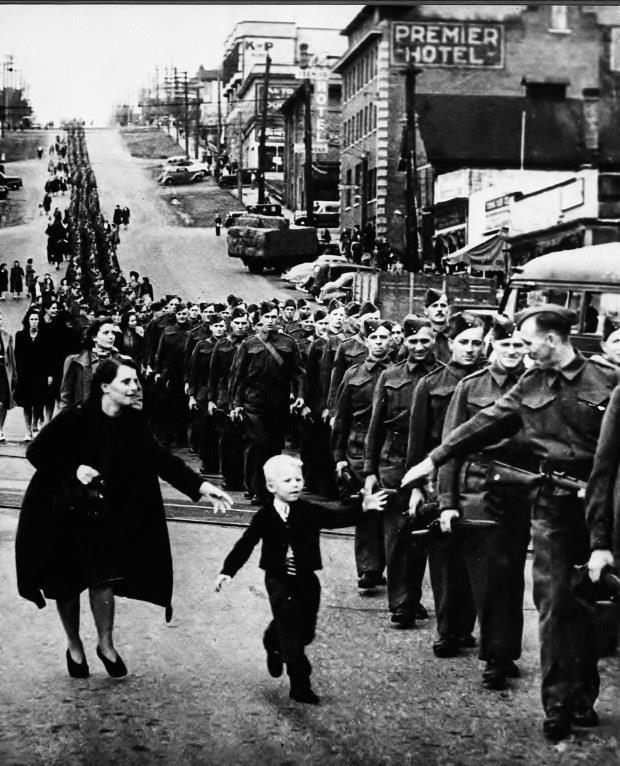
Image - Ernie Passmore in a 1940 picture taken on Granville Street, Vancouver by Ponsey
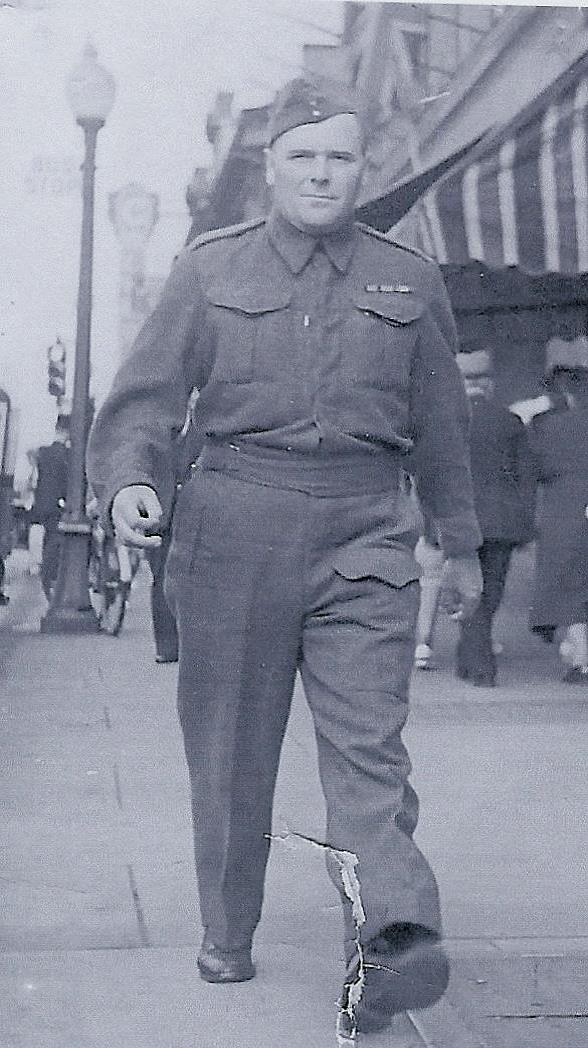
Ernie was able to see his dad and mother when the troop train stopped at Moose Jaw on the way to Halifax. They both died while he was overseas. His family in Vernon was driven to Kamloops by his brother Eddy and we all saw him when the troop train stopped there in July of 1941. He was then transported in a fast Convoy from Halifax to England. Upon arrival in England, he was transferred to Aldershot to the Ordinance Corps on November 15, 1941 and promoted to Lance Corporal.
Image - Ernie outside his army billet at Croydon, England
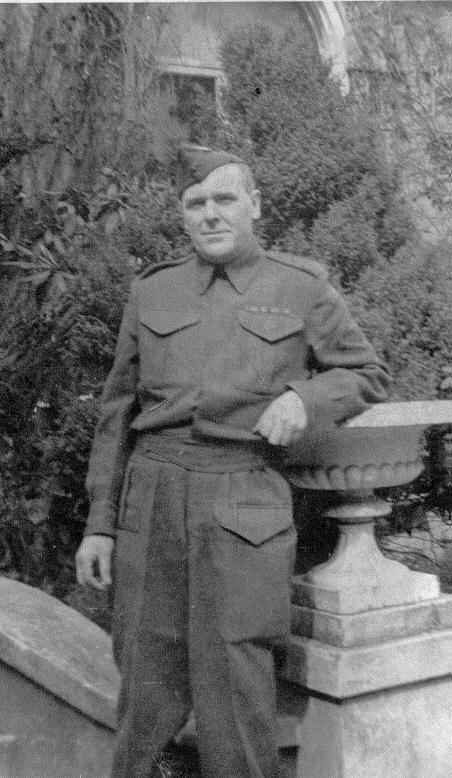
In January 1942 he was part of a Passmore reunion at Bournemouth, England that included cousins Cliff and Ernie of the South Saskatchewan Regiment, Percy and Lloyd Passmore of the RCAF along with their cousin Clarence Passmore of the RCAF and their uncle Cpl. Ernest Passmore of the RCEME.
Image - Percy, Ernie, Lloyd and Cliff Passmore January 1942 at a Passmore Reunion at Bournemouth
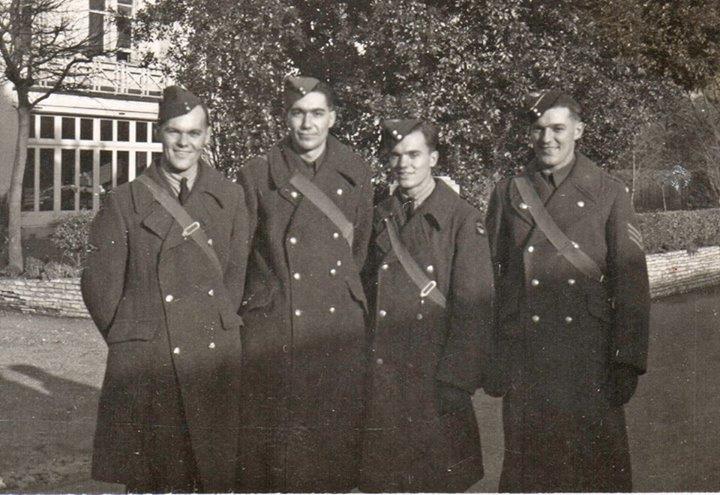
Image - Gunners with the 5th Light Anti-Aircraft Regiment, Royal Canadian Artillery, Croydon, England 1942. Ernie is in middle row far right.
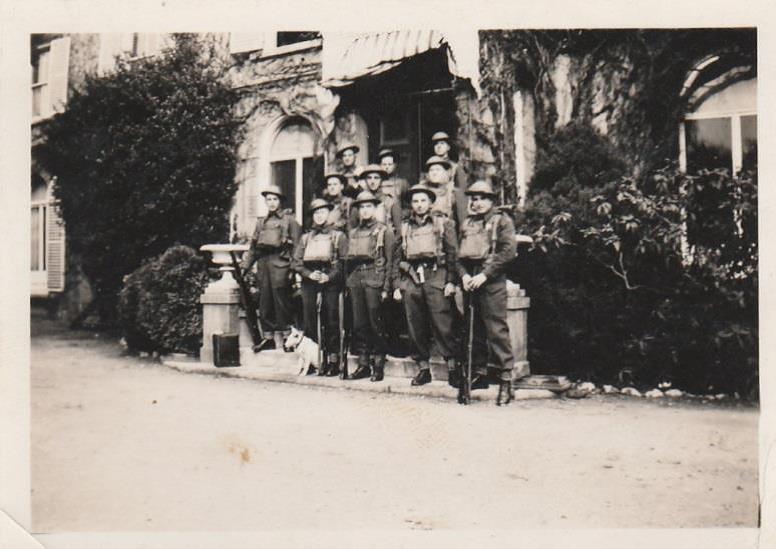
On February 2, 1942 he was promoted to T. R. P. “A" Electrician Class 2 with the 5th Light Anti-Aircraft Regt. Royal Canadian Artillery stationed at Croydon where they manned Bofers Anti-Aircraft guns during the blitz. He received The Defence of Britain Medal for this service.
Image - Bofors Light Anti-Aircraft Gun
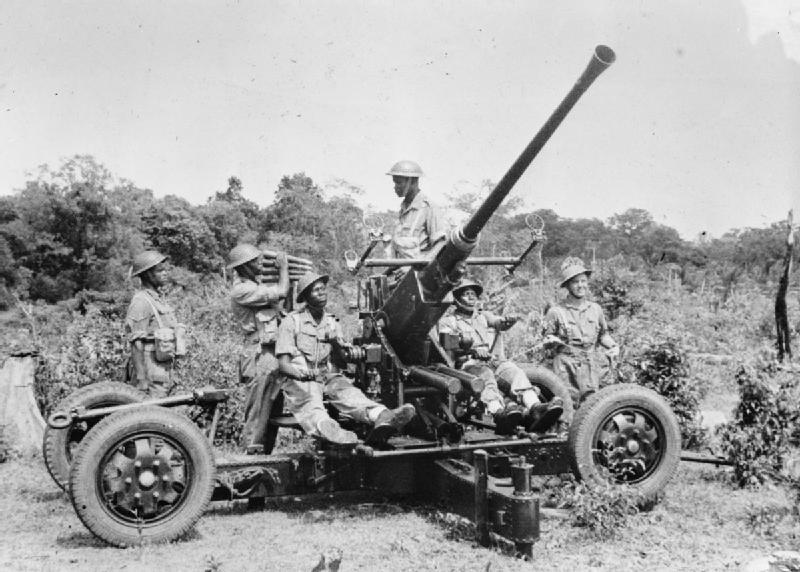
He was transferred to the Royal Canadian Electrical Mechanical Engineers at Aldershot in the summer of 1942 and remained there until Germany surrendered. He and a buddy were working on an overhead power line in an alley between huts at Aldershot when his buddy became entangled with a hot wire and couldn’t release himself. Ernie, knowing the danger, reached up and pulled his buddy down, saving his life. The current went through dad and paralyzed his left arm. He suffered for the rest of his life with a weakened arm.
After Germany surrendered, he spent a considerable time waiting for transport home after. He finally was returned to Canada in August of 1945.
He received his discharge from the army on October 13, 1945. In all, he served overseas six years and five months in the two Wars.
He died at the age of 67 on August 16, 1963 in Vernon. I have no doubt that his life was shortened by the stress and strain and wounds incurred during his military service overseas in two wars.
